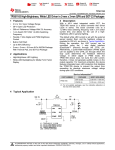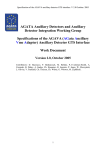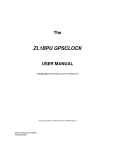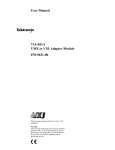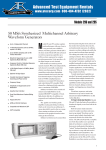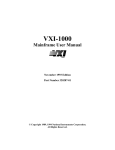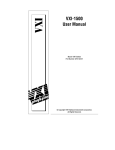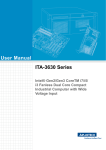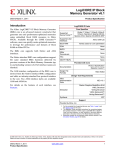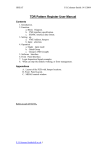Download EDOC 237 Clover Card User Guide v1
Transcript
EDOC237 EUROGAM Clover Card User Guide Version 1.0 July 1994 (updated August 1999) Author: Ian Lazarus Introduction The EUROGAM/EUROBALL Clover card fully instruments a EUROGAM Clover Ge detector and its associated BGO suppression shield. The inputs come from the Ge and BGO pre-amps and, after analogue signal processing, the output from the card is a series of energy and timing data words plus a hit pattern. The analogue signal processing is the same as used in the EUROGAM phase 1 Ge and BGO cards (full details are given later) except that there is no ballistic deficit correction in the Ge channels. This is not necessary since the crystals in the Ge detectors are smaller than those used in EUROGAM phase 1 and so ballistic deficit does not have such a significant effect on their resolution. For each Ge channel there is a high and a low gain (4MeV and 20MeV) energy measurement and 2 timing measurements (the peaking time and the difference in time between this channel and a global timing reference derived from the trigger system). The BGO channel provides a single energy measurement (typically 8MeV range) and a single timing measurement (the difference in time between this channel and a global timing reference derived from the trigger system). There is also a hit pattern to show which Ge detectors and which BGO elements are involved in the event. There are 4 Ge electronics channels plus an additional spare channel which can be cabled in and then reconfigured from software to take the place of any of the other 4 channels should a problem arise during an experiment. The BGO channel accepts signals from the 16 element shield in 8 pairs, each pair of phototubes driving its own pre-amplifier. Acknowledgements: The Clover card is a collaborative project and the following people have been involved: Engineer responsible for overall design: VXI interface and Readout design: CAD work including PCB design: Assembly work: Ge/BGO signal processing components: MIDAS and other software: Ian Lazarus (Daresbury Lab) Patrick Coleman-Smith (Daresbury Lab) Jim Thornhill (Liverpool University) Manchester University, Dept of Physics Electronics Workshop. Alphonse Richard, Zdravko Zojceski, M. Engrand (IPN Orsay) Germain Bosson (ISN Grenoble) Nabil Karkour (CSNSM Orsay) Michel Goyot (IPN Lyon) Charles Ring (CRN Strasbourg) Vic Pucknell, Simon Letts, Peter Owens (Daresbury Laboratory) For further help and information please contact Ian Lazarus at Daresbury Laboratory email [email protected] fax (0)1925 603173 telephone (0)1925 603433 1 Version 1.0 CCLRC, Daresbury Laboratory, Warrington, Cheshire, WA4 4AD, England Test pulser Ge Pre-amp signal 4MeV Uni Shaping amplifier (Quasi-triangular) Peak det & hold 20MeV Uni 20 MeV Bip 4MeV ADC TFA 20MeV ADC C/O Stop Peak time TAC Peak time TAC ADC FT TAC FT TAC ADC Start CFD Stop Inspection Points ROCI Channel Readout Chip (4 ADC/chip) To FIFO Includes Sliding Scale (Card Readout) Local Trigger To VXI Multiplicity Current sources Fast Trigger Validation BGO Veto x5 (for 5 Ge channels) Ge CFD outputs (5) BGO Veto out BGO Veto and other control logic Test pulser BGO Veto in Hold Veto pattern Pattern Unit and deadtime generator 8 Includes parallel to serial conversion 4 dual line receivers with LE discriminators . 8 inputs from charge preamps for each shield pair of BGO elements (s1-s8) 8 Shaping Amplifier (2µs) sums the 8 inputs Logical OR of all LE discriminators Peak det & hold To VXI Multiplicity Current source Energy ADC Channel Readout Chip (4 ADC/chip) Includes Sliding Scale Start Stop Inspection Points ROCI FT TAC To FIFO (Card Readout) FT TAC ADC Local Trigger Fast Trigger Validation Fig 1 Block diagram of Eurogam Phase 2 Detector Card 2 Version 1.0 CCLRC, Daresbury Laboratory, Warrington, Cheshire, WA4 4AD, England Ge Signal Processing Input: 200mV/MeV (±10%) pre-amp signal with 50Ω pre-amp output impedance. 50µs fall time constant (+/- 5%) 1K input impedance (approx.) Signal Shaping: Unipolar output from 6th order quasi-triangular filter. Peaking time of 4.4µs and FWHM 5 µs. Pulse width at 0.1% is 11µs. Output amplifier stage generates 4MeV and 20MeV ranges. Bipolar (differentiated) outputs available for crossover timing. Timing: CFD: min threshold 20keV, pulse pair resolution better than 1µs timing walk 3ns for 200:1 dynamic range, 25ns for 1000:1 (200ns Tr) (Figures from phase 1 Ge with 50ns delay; need to re-measure using new 27ns CFD) TFA with 50ns integration and 180ns differentiation. Gain x3 or x10. TAC 0-2µs, FWHM 0.6ns, INL <5% Outputs for coding: 4 MeV Unipolar signal 20 MeV Unipolar signal TAC measuring peaking time (CFD firing to bipolar crossover) TAC measuring channel firing time before reference pulse (CFD to FT) ADC: 13 bits resolution (8192 channels) Sliding scale Conversion time 4.5µs DNL <1% INL < 250ppm 3 Version 1.0 CCLRC, Daresbury Laboratory, Warrington, Cheshire, WA4 4AD, England BGO Signal Processing: Input: 1000mV/MeV pre-amp signal with approx. 5Ω pre-amp output impedance. (Phototube voltage must be adjusted to give 1000mV/MeV level.) 30ns rise time constant (+/- 10%) 10µs fall time constant (+/- 1.5%) 50Ω input impedance Signal Shaping: Bipolar output from 4th order semi-gaussian filter. (CR2 RC4, RC=2µs) Peaking time of 5.2µs and FWHM 5.5 µs. Pulse width at 0.1% is 12 x τ = 24µs. Output 8 MeV full scale Amplifier resolution is 3keV fwhm. Outputs for coding: 8 MeV Energy signal TAC measuring channel firing time before reference pulse (disc. to FT) Also a serial bit stream indicating the hit pattern from BGO and Ge. ADC: 13 bits resolution (8192 channels) Sliding scale Conversion time 4.5µs DNL <1% INL < 250ppm Clover Detector Card Interconnections * Primary interconnection mechanism is the VXI backplane as for phase 1. * The inputs from the Ge pre-amps are connected to the front panel by BNC sockets. * The BGO input is a 20 way IDC using similar LEMO-IDC cards to phase 1 but smaller to prevent misconnection of phase 1 shields to phase 2 electronics and vice versa. * LEDs are provided to indicate that BGO discriminators and Ge CFDs are firing as used in phase 1. A further LED is used to record FIFO errors (indicating readout problems). * Front panel rate monitoring is provided via a 34 way IDC connector. 13 differential ECL signal pairs are available from 5 CFDs and 8 BGO line receivers. * Backplane sumbuses and all other VXI connections are retained for full compatibility with phase 1. When the clover card is adjacent to phase 1 cards, the BGO local bus veto signals will be ignored and the Ge local bus Veto inputs will not be driven. * There are no external Veto inputs or outputs or external amplifier inputs. Pinouts for connectors are given in fig 2 on the next page. 4 Version 1.0 CCLRC, Daresbury Laboratory, Warrington, Cheshire, WA4 4AD, England FIFO error. (Readout problem s) Ge A LED for CFD on G e A Ge B Ge C Ge D Ge E P in 34 Detail of BGO Pinou t gn d 20 s8 s7 s6 s5 g nd 19 gn d Pin 1 g nd gn d P in 20 gn d s4 g nd s3 gn d s2 g nd s1 gn d g nd g nd 1 2 P ins 1,2 are ground P ins 3,5,7,9,11 are +ve Ge A-E P ins 4,6,8,10,12 are -ve Ge A -E P ins 14,16,18,20,22,24,26,28 are + ve BGO A-H P ins 13,15,17,19,21,23,25,27 are -ve BGO A -H P ins 29-34 are u nused. Rate monitoring outputs BG O input Pin 1 Fig 2 Front Panel for Clover Card 5 Version 1.0 CCLRC, Daresbury Laboratory, Warrington, Cheshire, WA4 4AD, England Operating Modes for the Clover Detector The anti-Compton veto system and sumbuses become more complex with a Clover detector than a conventional tapered detector in deciding what combination of detector hits comprises a clean hit, whether only 1 Ge may be hit (i.e. the Ge’s veto each other) or whether a combination of Ge hits is allowed and which parts of the BGO shield veto which Ge detectors. All possible combinations of Ge/BGO hit pattern are programmable in an 8kx4 memory using the 13 bit hit pattern as an address, with the 4 data bits determining which, if any, of the sumbuses (Raw Ge, Clean Ge, BGO) are to be turned on and whether or not to reject the event in hardware (or to mark it, depending on whether the card is in mark or reject mode). Three of the most useful modes of operation are available from the MIDAS software in the top level of the Clover card control menu. These modes are as follows: Typical Modes of operation (these are all available from MIDAS software): 1) Simple. In this case, all 5 Ge inputs (4 ‘real’ inputs + 1 spare) are treated as a single detector with a single BGO shield. When 1 or more Ge element fires, a multiplicity of 1 is indicated on the Raw Ge sumbus regardless of what happens in the BGO. The Clean Ge sumbus indicates a multiplicity of 1 if no element in the BGO shield has fired. If 1 or more BGO element does fire, then a multiplicity of 1 is indicated on the BGO sumbus and the Clean Ge sumbus current driver is inhibited. 2) Exactly One Ge. In this case exactly 1 of the 4 Ge inputs must fire, with the other 3 Ge inputs being used, along with the whole BGO shield, as anti-Compton vetos. The Raw Ge sumbus sees a multiplicity of 1 when 1 or more Ge elements fires (even though the 2nd Ge is part of the veto), but the Clean Ge sumbus indicates a multiplicity of 1 only if exactly 1 Ge has fired and no BGO element has fired. If 1 or more BGO element fires, then a multiplicity of 1 is indicated on the BGO sumbus and the Clean Ge sumbus current driver is inhibited. 3) Ignore Opposite Corner. This mode is similar to the “Exactly One Ge” mode except that intelligence is applied to the processing of the BGO shield. The 4 BGO elements in the opposite corner are ignored, for example: Ge A is “clean” if there are no hits in any of the BGO pairs s1,s2,s3,s4,s7,s8 or Ge B-D. (i.e. BGO elements i,j,k and l in s5 and s6 are ignored.) The Raw Ge sumbus sees a multiplicity of 1 when 1 or more Ge elements fires, but the Clean Ge sumbus indicates a multiplicity of 1 only if exactly 1 Ge has fired and there have been no BGO hits in the 12 relevant elements in the shield. If one or more BGO element (from the whole 16 element shield) fires, then a multiplicity of 1 is indicated on the BGO sumbus. Mode Simple Exactly 1 Ge Ignore Opp Corner Raw Ge Σ= 1 ≥ 1 Ge ≥ 1 Ge ≥ 1 Ge Clean Ge Σ= 1 ≥ 1 Ge & not AC = 1 Ge & not AC = 1 Ge & not AC BGO Σ= 1 ≥ 1 BGO ≥ 1 BGO ≥ 1 BGO Anti-Compton 16 BGO + 0 Ge 16 BGO + 3 Ge 12 BGO + 3 Ge 6 Version 1.0 CCLRC, Daresbury Laboratory, Warrington, Cheshire, WA4 4AD, England s8 o s7 p a b c n m l s6 s1 Ge D Ge A Ge C Ge B d e f k j i h s2 s3 g s5 s4 Fig 3 N aming scheme for Clo ver Ge and BGO elements show ing the mapping from 16 BGO elements to 8 BGO signals for the phase 2 electronics. Drawn: I.L. Nov 1992 7 Version 1.0 CCLRC, Daresbury Laboratory, Warrington, Cheshire, WA4 4AD, England MIDAS Software Interface For Clover Card. The following pages show typical screens from MIDAS software, used in Euroball to control the Clover Card. Fig 4 shows the Base Frame, and indicates that you should select the Card Setup menu, where you will find an entry for the Clover Card. The result of selecting this is shown in the same diagram. The enable buttons toggle the on/off function for each channel (also available from within the Ge and BGO submenus). This is the point at which the Suppression mode is selected (see page 6) and, in the event of a malfunction in one of the Ge channels, the spare channel configured . The Clover Card’s “Engineering” menu and “Readout” button are for use by engineers only and contain no user controllable functions. The more detailed Ge and BGO menus accessed from the Clover Card Setup menu (or directly from the Base Frame’s VXI Module Setup menu) are shown in fig 5 and fig 6 respectively. These 2 menus are very much the same as used for the phase 1 Ge and BGO cards. Note that for each Ge channel the PZ adjustment must be made for the specific detector/pre-amp attached, and should be checked before an experiment. Similarly, the FT sample and Val sample points (trigger timing) should be checked before each experiment. The sample points should be placed in the middle of the FT and Validation pulses respectively. The Ge channels have a common FT sample control, but the BGO channel has its own independent control to cope with the different characteristics of the two types of detector. The user controls which of the parameters are read out using the RO ticks at the top of each screen (fig 5 and fig 6). The sliding scale (SS) item should always be ticked except for the pattern for which the SS must never be enabled. The pattern includes not only the BGO, but also the Ge hit pattern. To help in setting up and checking the cards, some typical shapes of the signals on the inspection lines are shown in fig 7 to 10. 8 Version 1.0 CCLRC, Daresbury Laboratory, Warrington, Cheshire, WA4 4AD, England From the base frame select the VXI module Setup menu and the Clover Card item Fig 4 MIDAS Base Frame and Clover card menu selection. 9 Version 1.0 CCLRC, Daresbury Laboratory, Warrington, Cheshire, WA4 4AD, England Fig 5 Clover Card Ge channel control window 10 Version 1.0 CCLRC, Daresbury Laboratory, Warrington, Cheshire, WA4 4AD, England Fig 6 Clover Card BGO channel control window 11 Version 1.0 CCLRC, Daresbury Laboratory, Warrington, Cheshire, WA4 4AD, England PD S TFA in TFA ou t 4 Mev Bipolar FT TA C Unipolar (4 MeV/ 20MeV PZ ad ju st outp ut looks very similar in shap e to the unipolar signals, but includ es voltage limiting to avoid saturating oscilloscopes . Fig 7 Ge Analogue ins pection line signals 12 Version 1.0 CCLRC, Daresbury Laboratory, Warrington, Cheshire, WA4 4AD, England CFD d elayed Pileup PD S gate CFD d irect FT sam ple (FT exists) FT sam ple (no FT) Val sam ple (Val exists) Val sam ple (no val) LT reset reset if no FT reset if no val end r/ o AD C Encod e FT pulse Val Pu lse End of Conversion ROCI data ack ROCI data available AD C clock 4MH z Last P ass Or of A DC d ead tim es Fig 8 Ge Logic inspection signals 13 Version 1.0 CCLRC, Daresbury Laboratory, Warrington, Cheshire, WA4 4AD, England TA C Shaping amplifier PD S Test Pulser BGO inp ut a-h Line receiver outp ut a-h fig 9 BGO A nalogu e In spection Lines 14 Version 1.0 CCLRC, Daresbury Laboratory, Warrington, Cheshire, WA4 4AD, England BGO disable (high for norm al operation) BGO Valack BGO Encode Validation Pulse Inhibit LT reset (assum ing FT and Val sam ple d on't cause res ets) Start TA C FT pulse PD S gate FT sam ple Val sam ple Disc d ead tim e LT start BGO Disc a-h Width of pulse d ep end s on time taken by inpu t to drop below threshold fig 10 BGO logic ins pection lines 15 Version 1.0 CCLRC, Daresbury Laboratory, Warrington, Cheshire, WA4 4AD, England Details of registers and Addresses for Software Developers Address Space (offset into VXI address space) 0x0000 to 0x00fe 0x0100 to 0x01fe 0x0200 to 0x02fe 0x0300 to 0x03fe 0x0400 to 0x04fe 0x0500 to 0x05fe 0x0600 to 0x06fe 0x0700 to 0x07fe 0x2000 to 0x3ffe Name Ge Common parameters (“Channel 0”) Channel 1 Parameters (Ge A) Channel 2 Parameters (Ge B) Channel 3 Parameters (Ge C) Channel 4 Parameters (Ge D) Channel 5 Parameters (Ge Spare) Channel 6 Parameters (BGO) BGO Common parameters (“Channel 7”) Veto Pattern logic Table Channel 0 Sub-Address Spaces 0x0000 to 0x002e 0x0030 to 0x00fe Function Ge Common Parameters Module Parameters (common to Ge & BGO) Ge Common Parameters Name CFD Width DAC (8 bits) FT Sample Point DAC (8 bits) Validation Sample Point DAC (8 bits) LT watchdog DAC (8 bits) Test Generator Amplitude DAC (16 bits) Offset 0x0000 0x0002 0x0004 0x0006 0x0010 Access w w w w w Old Ge offset 0x0000 0x0002 0x0004 0x0006 0x0010 Access w r/w r/w r/w r/w r/w w r Old Ge/BGO offset 0x0030 0x0032 0x0034 0x0036 0x0038 0x003a 0c003c 0x003e (NB change) Module Parameters (Common to Ge and BGO parts) Name Analogue Multiplexor Selection Digital Multiplexor Selection Voltage Inspection Line Selection Controle des Fenetres Module Configuration Register Test Pulse Attenuator on/off (Ge only) Test Write to Readout Data FIFO Test Read from Readout Data FIFO Module Control Register (0x0038) d15-8 =x d7 d6 d5 0x38 Test Att CDF on not used on = 1 =1 Offset 0x0030 0x0032 0x0034 0x0038 bit 6 0x0038 0x0038 bit 7 0x003c 0x003c d4 not used d3 d2 1 = Reset not used FIFO d1 0 = Rej 1 = mark d0 LastCard =1 16 Version 1.0 CCLRC, Daresbury Laboratory, Warrington, Cheshire, WA4 4AD, England Channels 1-6 The addresses within the spaces allocated to channels 2 to 5 (Ge A to Ge E) are the same as on the phase 1 Ge Card. The addresses within channel 6 (BGO) are the same as those within channel 6 of the phase 1 BGO card. This permits the software to treat these channels exactly as at present which means that the EUROGAM Register Server software and the EG Session Ge and BGO windows can be used with few changes. Ge channel Parameters (Channels 1-5) Name CFD Threshold (8 bits) CFD Delay (8 bits) PZ adjust DAC (8 bits) PDS gate width DAC (8 bits) Channel Control Register Ge Channel control register: d15-8 =x d7 d6 0x120 etc not used not used Offset 0x0100 etc. 0x0102 etc. 0x0104 etc. 0x0106 etc. 0x0120 etc. d5 d4 1 = CFD 1=Test Disable Mode Access w w w w r/w d3 not used Old Ge offset 0x0000 0x0002 0x0004 0x0006 0x0020 d2 d1 TFA gain 1=low not used d0 not used BGO channel Parameters (Channel 6) Name BGO Threshold (12 bits) BGO Test Pulser (12 bits) Channel Control Register Offset 0x0600 0x0602 0x0620 BGO Channel control register (0x620): d15 d14 d13 d12 d11 d10 d9 n/u n/u n/u n/u n/u 1= Ch n/u dis. d8 n/u Access w w r/w Old BGO offset 0x0000 0x0002 0x0020 d7 d6 d5 d4 d3 d2 d1 d0 1=TG ON 1=TG ON 1=TG ON 1=TG ON 1=TG ON 1=TG ON 1=TG ON 1=TG ON BGO Common Parameters (Channel 7) Name Discriminator DeadTime DAC (8 bits) FT Sample point DAC (8 bits) Validation Sample Point DAC (8 bits) LT Watchdog (8 bits) PDS Gate Width DAC (8 bits) Offset 0x0702 0x0706 0x0708 0x070a 0x070c Access w w w w w Old BGO offset 0x0002 0x0006 0x0008 0x000a 0x000c 17 Version 1.0 CCLRC, Daresbury Laboratory, Warrington, Cheshire, WA4 4AD, England Inspection Lines The Ge and BGO inspection lines are combined as follows: Channel Channel 0 Channel 1 Channel 2 Channel 3 Channel 4 Channel 5 Channel 6 Channel 7 Function Disconnect Inspection Line Ge channel 1 Ge channel 2 Ge channel 3 Ge channel 4 Ge channel 5 (spare) BGO channel Ge common parameters (logic only) Channels 6 and 7 overlap on certain signals such as Fast Triggers and Validations, but since the Ge and BGO use different FT sample points, it is not unreasonable to keep the two sets of inspection lines entirely as they are now. This has the advantage also that all the phase 1 inspection line software can be re-used. The BGO elements s1-s8 map onto the old a-h inspection lines (analogue and digital); the old i and j inspection lines are not used on phase 2. The address mapping is not exactly as phase 1 and is shown in detail later along with the Voltage Inspection lines. Veto Pattern Look-up Table The pattern for Veto generation is loaded into a 8Kx4 memory array whose inputs are the pattern from the 8 BGO and 5 Ge discriminators and outputs are signals to determine the following: * Veto the event? * Drive Raw Ge sumbus? * Drive Clean Ge sumbus? * Drive BGO sumbus? This table is controlled by word access at addresses from offsets 0x4000-0x7ffe, each address corresponding to one possible pattern of discriminators. The pattern will be: not used not used not used Ge Sp Ge D Ge C Ge B Ge A s8 s7 s6 s5 s4 s3 s2 msb s1 lsb The data at each location is: not used not used not used not used 1= BGO 1= Cl Ge 1=Raw Ge 1= sumbus on sumbus on sumbus on event. d7 d6 d5 d4 d3 d2 d1 Veto d0 18 Version 1.0 CCLRC, Daresbury Laboratory, Warrington, Cheshire, WA4 4AD, England Multiplexors and Voltage Inspection Lines d15 d14 d13 d12 d11 d10 fn 5 fn 4 fn 3 fn 2 fn 1 ch 3 Multiplex (analogue and digital) line 2 d09 ch 2 d08 ch 1 d07 d06 d05 d04 d03 d02 fn 5 fn 4 fn 3 fn 2 fn 1 ch 3 Multiplex (analogue and digital) line 1 Ge (ch1-5) Function field: Analogue Muxes 0 1 2 3 4 5 6 7 Name PZ Adjust 4 MeV Unipolar 20 MeV Unipolar FT TAC out 4 MeV Bipolar TFA Output TFA Input 4MeV PDS BGO (ch6) Function field: Analogue Muxes 0 1 2 3 4 5 6 7 8 9 10 11 12 13 14 15 16 17 18 19 20 21 22 23 24 25 26 27 28 29 30 31 Name TAC output (mtxa110) Shaping Amp output (mtxa111) PDS output (mtxa112) Test Generator output (mtxa113) Renin* (active L) Renout* (active L) FIFOdtack (active H) Lecture (active H) BGO Input H (mtxa121) BGO Input G (mtxa120) BGO Input F (mtxa119) BGO Input E (mtxa118) BGO Input D (mtxa117) BGO Input C (mtxa116) BGO Input B (mtxa115) BGO Input A (mtxa114) Line Receiver output A (mtxa107) Line Receiver output B (mtxa106) Line Receiver output C (mtxa105) Line Receiver output D (mtxa104) Line Receiver output E (mtxa103) Line Receiver output F (mtxa102) Line Receiver output G (mtxa101) Line Receiver output H (mtxa100) BGO Input H (mtxa121) BGO Input G (mtxa120) BGO Input F (mtxa119) BGO Input E (mtxa118) BGO Input D (mtxa117) BGO Input C (mtxa116) BGO Input B (mtxa115) BGO Input A (mtxa114) d01 ch 2 d00 ch 1 19 Version 1.0 CCLRC, Daresbury Laboratory, Warrington, Cheshire, WA4 4AD, England Ge (ch1-5) Logic Inspection Function Select 0 1 2 3 4 5 6 7 Meaning CFD Delayed Output Pre-pulse Pileup PDS Gate CFD Direct Output FT Sample Point (W1) Val Sample Point (W2) LT reset ADC Encode Command BGO (ch 6) Logic Inspection Function Select 0 1 2 3 4 5 6 7 8 9 10 11 12 13 14 15 16 17 18 19 20 21 22 23 Meaning BGO Disable (mtxd118e) BGO Valack (mtxd119) BGO Encode (mtxd120) Validation Pulse Inhibit (Active Low) LT reset spare spare BGO TAC Start Pulse (mtxd110) Fast Trigger Pulse BGO PDS Gate (mtxd112) BGO Fast Trigger Sample Point (mtxd113) BGO Validation Sample Point (mtxd114) BGO LT RO gate test point (mtxd115) BGO Discriminator Deadtime (mtxd116) BGO LT Start (orcfd-orlrec) BGO disc h (mtxd100) BGO disc g (mtxd101) BGO disc f (mtxd102) BGO disc e (mtxd103) BGO disc d (mtxd104) BGO disc c (mtxd105) BGO disc b (mtxd106) BGO disc a (mtxd107) Common (ch 7) LI line function select Meaning 0 1 2 3 4 5 6 7 Fast Trigger Pulse Validation Pulse End of ADC Conversion ROCI Data Acknowledge OR all 6 ROCI Data Available (Active Low) ADC Clock (4 MHz) Last Pass OR of ADC deadtimes 20 Version 1.0 CCLRC, Daresbury Laboratory, Warrington, Cheshire, WA4 4AD, England Voltage Inspection Lines d7 d6 d5 d4 d3 d2 d1 not used V Select 4 V Select 3 V Select 2 V Select 1 Mux Sel 3 Mux Sel 2 Voltage Inspection Lines: Bottom 3 lines select the Mux chip, and next 4 lines address it. Voltage Inspection Code (Data 7..0) Meaning xxxxx 000 (0, 8, 16, 24 etc) x0000 001 (1) x0001 001 (9) x0010 001 (17) x0011 001 (25) x0100 001 (33) x0101 001 (41) x0110 001 (49) x0111 001 (57) x1000 001 (65) x1001 001 (73) x1010 001 (81) x1011 001 (89) x1100 001 (97) x1101 001 (105) x1110 001 (113) x1111 001 (121) x0000 010 (2) x0001 010 (10) x0010 010 (18) x0011 010 (26) x0100 010 (34) x0101 010 (42) x0110 010 (50) x0111 010 (58) x1000 010 (66) x1001 010 (74) x1010 010 (82) x1011 010 (90) x1100 010 (98) x1101 010 (106) x1110 010 (114) x1111 010 (122) x0000 011 (3) x0001 011 (11) x0010 011 (19) x0011 011 (27) x0100 011 (35) x0101 011 (43) x0110 011 (51) x0111 011 (59) x1000 011 (67) x1001 011 (75) x1010 011 (83) x1011 011 (91) x1100 011 (99) x1101 011 (107) x1110 011 (115) x1111 011 (123) xxxxx 1xx Not connected to VXI Ge 1 CFD Threshold (VO1(1)) Ge 1 CFD Output Delay (VO1(2) Ge 1 PZ Adjust (VO1(3)) Ge 1 PDS gate (VO1(4)) Ge 2 CFD Threshold (VO1(5)) Ge 2 CFD Output Delay (VO1(6)) Ge 2 PZ Adjust (VO1(7)) Ge 2 PDS gate (VO1(8)) Ge 3 CFD Threshold (VO2(1)) Ge 3 CFD Output Delay (VO2(2) Ge 3 PZ Adjust (VO2(3)) Ge 3 PDS gate (VO2(4)) Ge 4 CFD Threshold (VO2(5)) Ge 4 CFD Output Delay (VO2(6)) Ge 4 PZ Adjust (VO2(7)) Ge 4 PDS gate (VO2(8)) Ge 5 CFD Threshold (VO3(1)) Ge 5 CFD Output Delay (VO3(2) Ge 5 PZ Adjust (VO3(3)) Ge 5 PDS gate (VO3(4)) Ge Test Pulser Output Level CFD Width Ge Fast Trigger Sample Point (DW1) Ge Validation Sample Point (DW2) Ge LT timeout (DW3) BGO Threshold BGO Test Pulser Output Level (MTXC6) BGO DAC ref (MTXC13) BGO Fast Trigger Sample Point (MTXC15) BGO Validation Sample Point (MTXC16) BGO LT Timeout (MTXC17) BGO PDS Gate (MTXC18) VREFDAC (Ge DAC reference) Vee24 Vee18 Vee12 Vee6 Vee (-5.2V) Vee2 +3V regulator (BGO DAC ref) Ground Vcc5 Analogue Vcc5 Digital Vcc6 Vcc12 Vcc18 Vcc20 Vcc24 Connected to VXI, but not allocated on card d0 Mux Sel 1 21 Version 1.0 CCLRC, Daresbury Laboratory, Warrington, Cheshire, WA4 4AD, England Inhibit and Sumbus System description (added April 1996) The Inhibit system logic applies a card level inhibit (signal name inhibecom) whenever one of these 2 conditions is true using a logic OR (IC 17, 27 and 28 on page 11 of circuits): 1) The system’s Inhibit Action VXI line is true (0v on backplane) 2) The card is set to Reject (not Mark) mode AND either there is pre-pulse pileup in one of the 5 Ge channels OR there is a Veto from the Sumbus/Veto LookUp Table. The duration of the card level inhibit is set by: 1) the duration of the system’s Inhibit Action signal (until end of readout in CDT mode) 2) the duration of the pre-pulse pileup (7µs) or the Veto (until LT reset) If both conditions are true then the duration is set by the longer. The front edge of the card level inhibit is also used to enable the serialisation of the status of the input pattern by the pattern unit (M30). This level must be maintained until parallel to serial conversion is finished. The inhibit to each of the LT circuits has an inhibit over-ride using that LT’s LtStartN signal which prevents the application of an inhibit once the LT is busy. (If Inhibit is applied to a busy LT and the LT’s CFD fires again, then that LT will be reset prematurely.) The sumbus drivers are controlled by a PAL which gates the LUT output with a delayed version of the OR of the Ge CFD outputs. Whenever the CFD’s fire, the current pattern of local trigger LtStart signals and BGO line receivers which is applied to the LUT will determine whether or not the sumbuses are driven. In the case of the Ge LT’s this will be “stale” latched information if there is a card level inhibit preventing changes in LT state. In parallel mode the InhAction signal will be short, but the card level inhibit will be extended to 7µs by the pre-pulse pileup (amplifier busy) signals if the reject mode is enabled. Check how long it takes to serialise the LtStart pattern: maybe we need to stretch the InhAction locally to make a proper card deadtime signal? Sumbus deadtime (Added August 1999) The sumbus inhibit problem described above has a second effect which is to disable the sumbus Ge outputs while Inhibit Action is asserted, regardless of whether this clover is part of the event. The problem can be overcome for the Raw Ge sumbus only in the LUT by programming the all the RawGe entries to be always 1 so that the Raw Ge sumbus is driven whenever the OR of the Ge CFDs is true, regardless of the Ge pattern bits from the LT Start signals. This method can be extended to a simple suppression on the Clean Ge sumbus too by programming the LUT with a “don’t care” state in all the 5 Ge bits and using the OR of the Ge CFDs to indicate that one or more of the Ge channels has been hit. The Clean sumbus output from the LUT would be driven then whenever all 8 BGO bits are 0 and the OR of the Ge CFDs is true, regardless of the state of the 5 Ge LT start LUT inputs. NB this LUT configuration is incompatible with the complex Ge pattern based Vetos, but these are rarely/never used anyway so it is not really a problem that they are unavailable. 22 Version 1.0 CCLRC, Daresbury Laboratory, Warrington, Cheshire, WA4 4AD, England Data Format Description (Added August 1999) The data format produced from the Clover card readout is as follows: Q1 Q0 Qualifiers See below D31 D30 I5 I4 I3 I2 I1 I0 Item Identifies parameter within clover D29 D28 D27 D26 D25 D24 G7 G6 G5 G4 G3 G2 G1 G0 Group MIDAS sets this within range allocated to clovers D23 D22 D21 D20 D19 D18 D17 D16 The top 16 data bits always look like this and are followed by 16 bits of data as follows: Pattern word: not used D15 not used D14 not used D13 Ge E D12 Ge D Ge C Ge B Ge A s8 s7 s6 s5 s4 s3 s2 s1 D11 D10 D09 D08 D07 D06 D05 D04 D03 D02 D01 D00 E E E E E E E E E E D10 D09 D08 D07 D06 D05 D04 D03 D02 D01 E LSB D00 T T T T T T T T T T D10 D09 D08 D07 D06 D05 D04 D03 D02 D01 Energy Data Words (all types): not used D15 not used D14 not used D13 E E MSB D12 D11 TAC Data Words (all types) not used D15 not used D14 not used D13 T T MSB D12 D11 T LSB D00 Qualifiers: The Ge qualifiers have the following meanings depending on which data word they come with: Q1, Q0 00 01 10 11 Spectrum q0 q1 q2 q3 20MeV 4MeV clean data clean data A/C Veto A/C Veto Pileup Pileup (pre or post) (pre or post) Pileup and A/C Pileup and A/C Veto Veto FT TAC all data not used not used CO TAC no pileup post-pulse pileup pre-pulse pileup not used pre and pileup post The BGO qualifiers are always set to 1,1 for compatibility with the EG 1 BGO cards. 23 Version 1.0 CCLRC, Daresbury Laboratory, Warrington, Cheshire, WA4 4AD, England Warning Users must not remove the shields from the cards. There are no user serviceable parts inside. There are, however, static sensitive components which can be easily damaged by incorrect handling procedures. Jumpers. These adjustments should not be attempted by a user. Please contact an engineer. ST 1,2,3,4,5 must always be inserted to ground the positive input to the shaping amplifiers. ST8 controls whether the sliding scale is on or off. Shipped in the “on” position. Top=On Bottom = Off ST20 controls whether the BGO channel is started by just the OR of the 5 Ge CFDs or the OR of the BGO inputs OR'ed with the 5 Ge CFDs. Shipped in the “BGO or Ge” position. Top=Ge only Bottom= Ge OR BGO Adjustments. There are no user adjustments on the card itself. The ADC sliding scale is set during commissioning and should not be changed. (On the ADC there are 2 pots: 47k sets DC level and 1k sets gain for SS adjustment.) The sumbus current output levels are set during commissioning and should not be changed. (R244 sets BGO sumbus, R274 sets Clean Ge sumbus, R300 sets Raw Ge sumbus) Power supplies. Voltage -2V +5V -5.2V +12V -12V +24V -24V Typical current (amps) 0.5 2.3 6.1 1.9 1.6 0.1 0 Typical Power (Watts) 1 11.5 31.8 22.8 19.2 2.4 0 Total 89 Watts --- End of document --- 24 Version 1.0 CCLRC, Daresbury Laboratory, Warrington, Cheshire, WA4 4AD, England
























